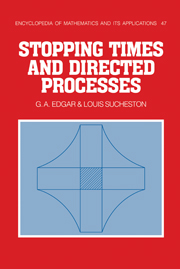5 - Banach-valued random variables
Published online by Cambridge University Press: 21 January 2010
Summary
In this chapter, we consider martingales, amarts, and related processes that take values in Banach spaces. They are useful in Banach spaces that occur naturally in mathematics, such as function spaces. They have also played an important role in the understanding of some geometric properties of Banach spaces. The reader who knows nothing of Banach spaces should, of course, skip this chapter; but someone with only a minimal knowledge of Banach space theory should be able to work through most of the chapter, with the exception of Section 5.5.
There is a close connection between martingales with values in a Banach space E and measures with values in E. This is not unexpected. More interesting are the connections of these two topics with the geometric properties of the Banach space. These are explored in Section 5.4.
If a theorem is true in the real-valued case and extends to a more general setting without change of argument, this may be useful, but is hardly exciting. One modern approach to probability in Banach space consists in exactly matching the convergence property to the geometry of the space. Such theorems are not only the best possible in terms of convergence, but they may also shed new light on the structure of the space. The remarkable theorem of A. & C. Ionescu Tulcea and S. D. Chatterji (that L1-bounded martingales taking values in a Banach space E converge a.s. if and only if E has the Radon-Nikodým property, Theorem (5.3.30); also (5.3.34)) characterizes a geometrical property of Banach spaces in terms of convergence of martingales. It will be seen that there are many such characterizations in terms of amarts.
Information
- Type
- Chapter
- Information
- Stopping Times and Directed Processes , pp. 171 - 253Publisher: Cambridge University PressPrint publication year: 1992
